





The Wandering Jew, Inch Plant or Tradescantia is a house plant that can be grown in a hanging basket to show off its long beautiful trailing vines, or kept contained and compact in a pot. Very versatile, very easy and very hard to kill, makes this a very good indoor plant to have around.
"How do I care for my Wandering Jew plant?" and "Wandering Jew Plant for sale" are two big hitters when it comes to our visitors searching online about this popular and easy care house plant. 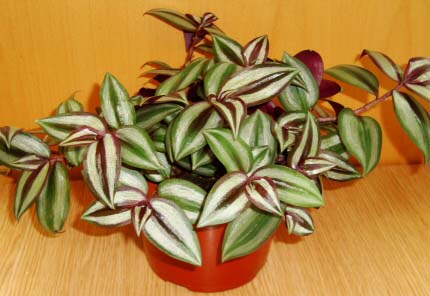 We would suggest Amazon.com or Amazon.co.uk to kick start the buying hunt, and our article below will (hopefully) answer the first question for you.
We would suggest Amazon.com or Amazon.co.uk to kick start the buying hunt, and our article below will (hopefully) answer the first question for you.
To start things off, a lot of people also want to understand the common names this plant goes by - the Wandering Jew Plant and the Inch Plant. Both names are centered around its ability to spread and grow very quickly, with little care or intervention from people. The Wandering Jew is a legend which basically follows that a Jewish man was cursed to walk the earth forever, therefore like this plant the Jew will eventually go everywhere. The "inch" plant name probably comes from a combination of the stem's ability to grow about an inch every week, and also because only an inch of this plant is needed to propagate itself.
There are several popular varieties of Tradescantia Zebrina for sale each sharing the recognisable glistening leaf surface and purple underside. T. zebrina 'quadricolor' has green, silver, pink and red leaf markings, whereas T. zebrina 'purpusil' has a green and purple blend.
Tradescantia fluminensis is a very close relative to T. Zebrina (or Zebrina pendula as it used to be called) and is also known as the Wandering Jew Plant. Although it's much less popular these days its care requirements are identical to T. Zebrina except it will cope better with a slightly darker position. 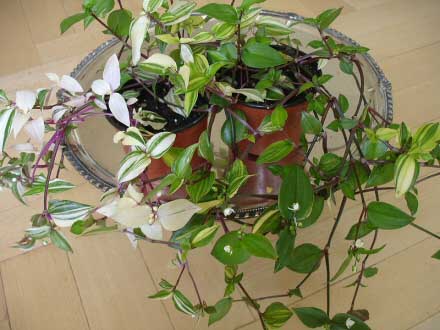 As it has much more green in the leaves T. fluminensis is very plain so instead look out for some of the varieties such as T. fluminensis 'variegata' or T. fluminensis 'quicksilver', these have cream and white stripes to give it a bit more of a visual punch. Mix several types in one pot for an extra hit.
As it has much more green in the leaves T. fluminensis is very plain so instead look out for some of the varieties such as T. fluminensis 'variegata' or T. fluminensis 'quicksilver', these have cream and white stripes to give it a bit more of a visual punch. Mix several types in one pot for an extra hit.
We should mention that the Wandering Jew Plant outdoors tends to become an Invasive species if not properly maintained as it's difficult to eradicate because if only an inch of it survives it will live on. That said, our focus is on the indoor grower and so it's potentially invasive nature outdoors isn't a problem. The Wandering Jew Plant is safe to have around cats and people, the sap however can be irritating so either wear gloves or wash you hands immediately if you come into contact with the sap.
Light
All Tradescantias including the Wandering Jew Plants need plenty of light to retain the variegated colours on the leaves, if things are too dim these will fade. On the other side of the coin if too much light is provided leaf scorching is the end result, fortunately however the problem of "too much light" is basically only caused by excessively exposed locations during midsummer. This is quite hard to provide indoors anyway, so you will only really risk this if you Summer your plants outdoors.
Water frequently when the plant is growing and cut back once growth slows down
Watering
As you would expect from any hard to kill house plants, the Wandering Jew will cope with droughts and a little water logging from time to time. Try to avoid this careless watering approach where possible though as a good looking plant needs to be watered correctly. The instruction here is simple, water the Wandering Jew regularly and freely during the warmer seasons to try and keep the soil moist for much of the time. In Winter cut right back because growth will slow or stop completely and the need for water will reduce drastically as a result.
Humidity
The leaves are almost succulent like and therefore humidity is something you don't have to worry about too much. It will be worth misting the plant however if you start to notice the leaves becoming shriveled or brown leaf tips start to appear. You can also grow Wandering Jew in a indoor bottle garden.
Feeding
Opinion is often divided about how much and how often you should feed Wandering Jew Plants. 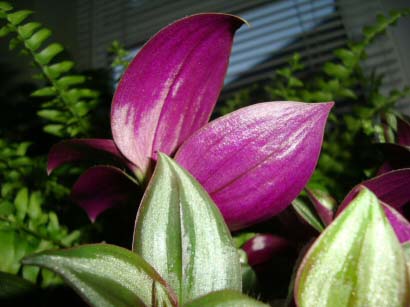 Some will suggest regular heavy feeding, perhaps as much as every other watering and others will say only once or twice a year at most, otherwise it will encourage the variegated leaves to turn green. The truth of it is that this plant will cope with almost anything you give (or don't give) it.
Some will suggest regular heavy feeding, perhaps as much as every other watering and others will say only once or twice a year at most, otherwise it will encourage the variegated leaves to turn green. The truth of it is that this plant will cope with almost anything you give (or don't give) it.
We fertilise normally (back of the bottle instructions) once a month and the OurHousePlant.com's Inch Plant is as good looking as the day it was brought.
Temperature
Give your plant average warmth conditions for quick growth, a cooler room of around 10°C / 50°F is also suitable too. In fact the only no no, is exposure to frost or really chilly temperatures. Frost will do serious damage and chilly locations will cause leaf discoloration.
Repotting
It's best to repot once a year to give a little more space for the roots to grow, but as with everything else to do with this plant it will still cope living in the same soil for years. This is handy if you have chosen to grow it in a hanging basket as these can be fiddly to upsize and can also be a little difficult to work with. When you do repot though, normal potting soil is a great choice, just make sure you avoid mixes with a heavy manure content and don't use ordinary dirt from your yard.
Propagation
When it comes to propagation of Wandering Jews only the Spider Plant is easier and more reliable to work with. The success rate of Spider Plants is something like 99% and the Wandering Jew, 98%, so either way its still incredibly easy to grow more plants.
The stems are quite brittle so an accidental knock or an intentional snip on an existing and you have a Wandering Jew Plant stem cutting ready to go. 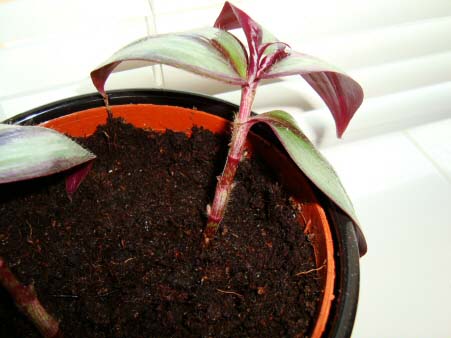 You don't need to wait for the fresh cut end to dry out a bit, nor do you need to use any type of rooting hormone , it's just a case of pushing the cutting a few centimeters into a fresh potting mix, water well and away you go.
You don't need to wait for the fresh cut end to dry out a bit, nor do you need to use any type of rooting hormone , it's just a case of pushing the cutting a few centimeters into a fresh potting mix, water well and away you go.
To do this you'll need a cutting which is at least an inch long and has at least one leaf, although ideally for quicker results you will want a cutting that is several inches long and several leaves already in place (like what you can see in the photo above). New growth will start up in a matter of weeks.
The cuttings take time to become bushy and to fill a pot, so because of the ease at which propagation can be done it's usually more effective to take several cuttings and put them all into the same pot. The results of this after a few months will be a pot where all the cuttings have knitted together nicely to give the illusion of one plant when in fact it's actually several.
Speed of Growth
The growth rate of Wandering Jew Plant's when temperatures are warm is fast. Its natural tendency is to "vine" and spread out, so if you aren't growing this in a hanging basket or you want to grow a neat compact looking plant then you must prune regularly to keep it tidy (don't forget the pruned stems can be used to propagate new plants).
Height / Spread
The height of this plant won't ever go beyond 6in / 15cm however each single stem can eventually grow to 6ft / 1.8M. This type of spread maybe what you are looking for of course i.e. if you want it to trail down from a hanging basket perched up high, but the stems can always be kept shorter by pinching out the growing tips on a frequent basis.
Flowers
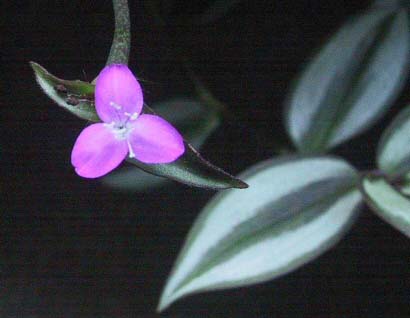 The Wandering Jew Plant is another house plant which is grown for it's foliage rather than the flowers it produces, however they can still add a nice touch when they appear. The pink or purplish flowers these plants produce will be small and can appear at any time of the year, although it's much more likely in late Spring early Summer.
The Wandering Jew Plant is another house plant which is grown for it's foliage rather than the flowers it produces, however they can still add a nice touch when they appear. The pink or purplish flowers these plants produce will be small and can appear at any time of the year, although it's much more likely in late Spring early Summer.
Anything else?
Your plant is looking tired, it's become leggy and unattractive, convinced you have done something wrong you google "Wandering Jew care instructions" to try and find out how to fix things. The answer you'll find will be pretty much the same everywhere because as any owner of this plant will tell you, this "look" is inevitable. The vines grow long quickly and over time as they age the older leaves yellow and fall off creating the appearance you feel you've caused through poor treatment, which isn't usually the case. Basically it has pushed itself away from the centre so you can start again by taking cuttings and next time prune more frequently to encourage everything to keep closer to the container holding the soil.
Copyright © www.100flowers.win Botanic Garden All Rights Reserved